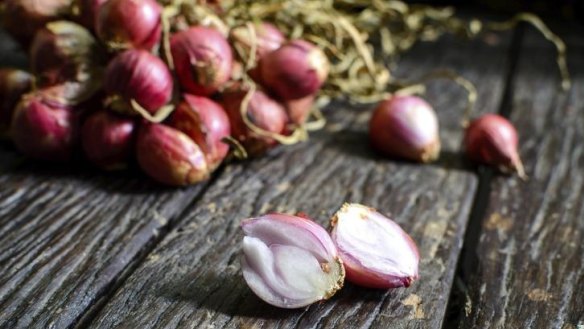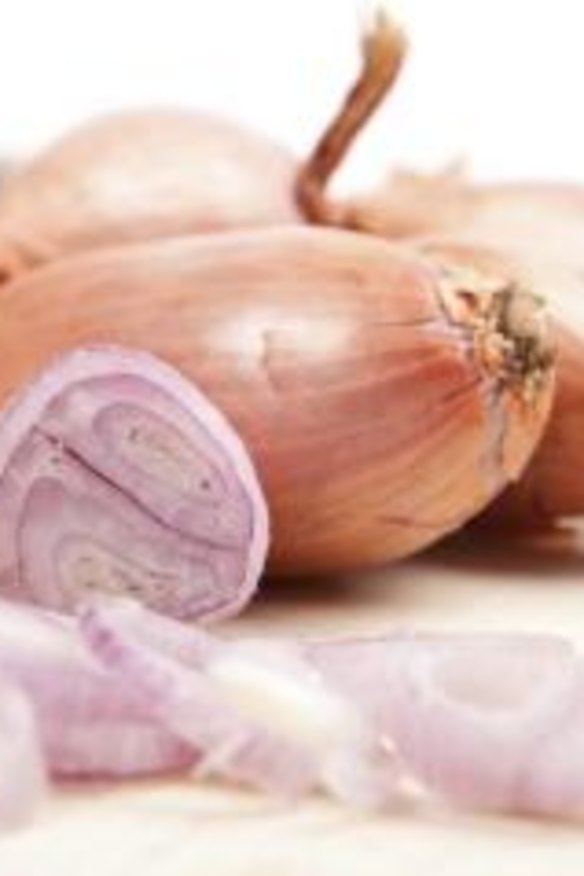Owen Pidgeon's top tips for growing shallots in Canberra

In writing about growing and using shallots, you might be excused for thinking that we are running a series of articles about "what is in a name". But this time, it is all about the regional differences found in Australia.
Shallots are known to Europeans as eschalots, the small brown-skinned member of the onion family. True shallots are grown for their bulbs only but in parts of Australia spring onions are incorrectly sold as shallots. The unique feature of shallots is that the single set (the small bulblet) will begin to produce a clump of 10-12 bulblets over its growing season. This is recognised in the botanical name for shallots, Allium aggregatum.
Shallots are small and the easiest way to plant them is to separate out the divisions of the bulbs and plant out as you would garlic cloves. This is best done in late autumn for a late spring harvest. Space them 15 centimetres apart along a prepared shallow trench. Do not press them down into the garden bed as it can compact the soil and hinder the root growth. Allow 25 centimetres to 30 centimetres between rows if you decide to establish a big garden.

The other way to grow shallots is to purchase a packet of seeds and start them indoors, in a propagation tray, as you would do with standard onions. Golden shallots have a wonderful, delicate flavour and are suitable for growing in cooler climates. 'Roderique' is one variety of shallot available in Australia that has its origin in France. It has a distinctive flavour and is widely used raw in salads and also for flavouring red-meat dishes
Red shallots have a distinctive red skin and the flesh is pale, purple-pink in colour. Red shallots are somewhat smaller but sweeter than the golden shallot. Their subtle flavour means it is widely used in Asian cooking, especially Thai cuisine. 'Ambition' is a good variety to plant.
Shallots have a superb, mild flavour so they can be used in many dishes. Add them whole to casseroles, serve them whole in a baked dinner fry or pickle them. As winter approaches, consider using shallots as a key ingredient in winter soups, casseroles and other slow-cooked dishes. They can be stored for many months.
As with other onions, shallots grow best in a sheltered, sunny location. Dig in plenty of fully decomposed compost and do not add fresh manure or fertilisers, as a high level of nitrogen in the soil will lower the keeping qualities of the mature shallots.
Keep your garden beds of shallots (and all onions and garlic) weed-free to allow them to grow unhindered by competition. They have shallow roots so take care when weeding. Keep the soil moist around the plants during the growing season and apply a thin layer of mulch to help with moisture retention. When the bulblets begin to appear around the base of the plants, gently hill up soil around them to produce some blanching
Harvest the foliage of some of your the shallots in spring, when the leaves have grown at least 10 centimetres tall. Otherwise, allow the plants to fully mature. Do not cut off any green foliage as this may result in fungal infections.
Harvest when the tops have dried off by using a three-pronged fork to gently lift them out of the garden bed. The base of each shallot will comprise around 12 sets, lightly attached to each other. On the other hand, do not allow your shallots to stay too long in the garden after they mature. Allow them to cure first in sunshine, then on a wire drying rack in the shade for some days. Break up the bulbs and store them in a dry, well-ventilated place, on slatted trays or in net bags. They will then keep for many months.
Roast chicken breasts with shallots
1 kg free-range chicken breasts
12 shallots
3 tbs olive oil
2 tbs apple cider vinegar
1 tbs soy sauce
salt and ground black pepper
300g baby carrots
Peel all the shallots and finely chop just four of them. Mix the chopped shallots in a small bowl with the olive oil, apple cider vinegar, soy sauce, salt and pepper. Toss the chicken breasts in the mixture and make sure that they are well coated.
Place the chicken breasts and remaining whole shallots into a roasting pan and cook at 220C for about 20 minutes, until the chicken pieces begin to brown. Turn over and baste the pieces with the juices in the pan. Place the remaining shallots and baby carrots in the pan and cook for a further 20 minutes until the chicken is golden brown and the small shallot pieces have caramelised.
Serve with organic broccoli and creramy mashed potatoes.
This week in the garden
- Sow cream, gold and red spanish onion seeds into propagation trays and cover with only a thin layer of seed-raising mix. Keep in a warm place to assist germination.
- Harvest jerusalem artichokes, mature kohlrabi and kale.
- Fold over the outside leaves of cauliflowers to help produce brilliant white heads.
- If space, plant rows of broadbeans and shelling peas to produce a fine spring harvest and also boost the nitrogen levels of garden beds.
- When pruning fruit trees, first cut out broken branches, trim off any rootstock shoots and seriously cut back branches that have reached for the sky.
Owen Pidgeon runs the Loriendale Organic Orchard near Hall.
Restaurant reviews, news and the hottest openings served to your inbox.
Sign up